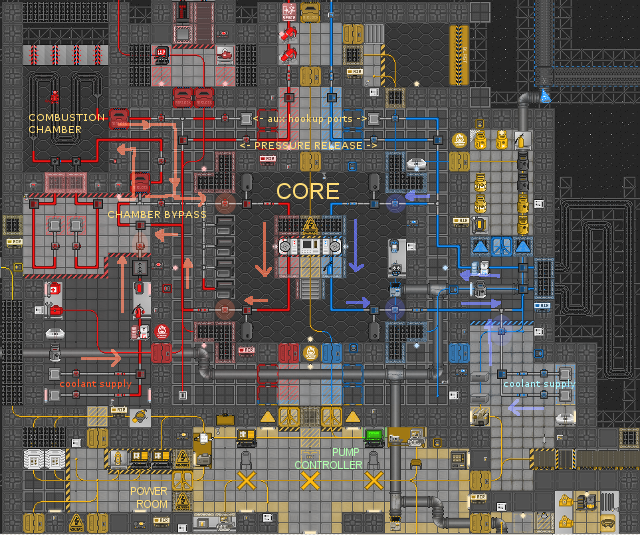Powering the station
Thermo-Electric Generator Startup Procedure for Mark I Plasma-Fired Engines
Warning! Improper engine and generator operation may cause exposure to hazardous gasses, extremes of heat and cold, and dangerous electrical voltages. Only trained personnel should operate station systems. Follow all procedures carefully. Wear correct personal protective equipment at all times. Refer to your supervisor or Head of Personnel for procedure updates and additional information.
Standard checklist for engine and generator cold-start.
1. Perform visual inspection of external (cooling) and internal (heating) heat-exchange pipe loops. Refer any breaks or cracks in the pipe to Station Maintenance for repair before continuing.
2. Connect a CO2 canister to the external (cooling) loop connector, and release the contents. Check loop pressurization is stable. Note: Observe standard canister safety procedures. Note: Other gasses may be substituted as a medium in the external (cooling) loop in the event that CO2 is not available.
3. Connect a CO2 canister to the internal (heating) loop connector, and release the contents. Check loop pressurization is stable. Note: Observe standard canister safety procedures. Note: Nitrogen may be substituted as a medium in the internal (heating) loop in the event that CO2 is not available. Do not use plasma in the internal (heating) pipe loop as an unsafe condition may result.
4. Using the thermo-electric generator (TEG) master control panel, engage the internal and external loop circulator pumps at 1% maximum rate.
5. Ignite the engine. Refer to document NTRSN-113-H9-12939 for proper engine preparation, ignition, and plasma-oxygen loading procedures. Note: Exceeding recommended plasma-oxygen concentrations can cause engine damage and potential hazards.
6. Monitor engine temperatures until stable operation is achieved.
7. Increase internal and external circulator pumps to 10% of maximum rate. Monitor the generated power output on the TEG control panel. Note: Consult appendix A for expected electrical generation rates.
8. Adjust circulator rates until required electrical demand is met. Note: Generation rate varies with internal and external loop temperatures, exchange media pressure, and engine geometry. Refer to Appendix B or your supervisor for locally determined optimal settings. Note: Do not exceed safety ratings for station power cabling and electrical equipment. With the power generation rate stable, engage charging of the superconducting magnetic energy storage (SMES) devices. Total SMES charging rate should not exceed total power generation rate, or an overload condition may occur.
